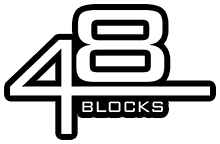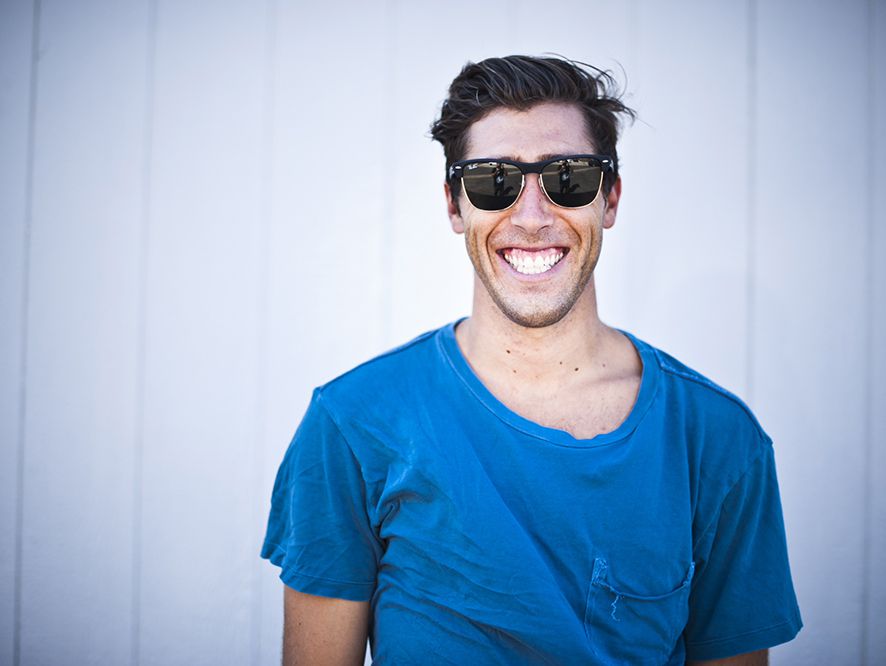Mike Taylor is incredibly determined. Over the course of 12 years—the time I’ve known him—skateboarding has always been one of Mike’s top priorities. Mike is the kind of guy who will eschew all hobbies that might hamper his skating; he surfs because it takes place in the morning, which gives him a whole day (and night) to skate afterwards. Mike’s drive and his innate skating ability are the reasons why he has continued to put out standout skate parts for the past eight years (starting in 2001 with City Stars’ Street Cinema). He’s also one of the nicest guys you’re bound to meet. I’m just honored to have seen Mike’s skating develop from nearly the beginning. He came up with a crew of heavy hitters (notably Justin Case and Van Wastell) whose influence is present in every trick Mike does. He certainly makes all of us proud.
Photo and interview by Ryan Leach
Ryan: We skated together a lot growing up, Mike. But we didn’t start at the same time. You began a year after me in 1996. Oddly, I don’t think you’ve ever told me how you got into skateboarding.
Mike: Initially, I was just into riding bikes. There was a school in Agoura (California) called the Ad School that I would ride my bike to. I would see a lot of the cool kids skating there—like J.T. Aultz and Spanky. After seeing them a few times, I thought to myself, “Damn, I’ve got to get a skateboard.” So I bought one and went from there. This was just before I turned 14. What’s odd about it is I never really skated with J.T. or Spanky. A lot of my friends started skateboarding at around the same time that I did, so we learned together.
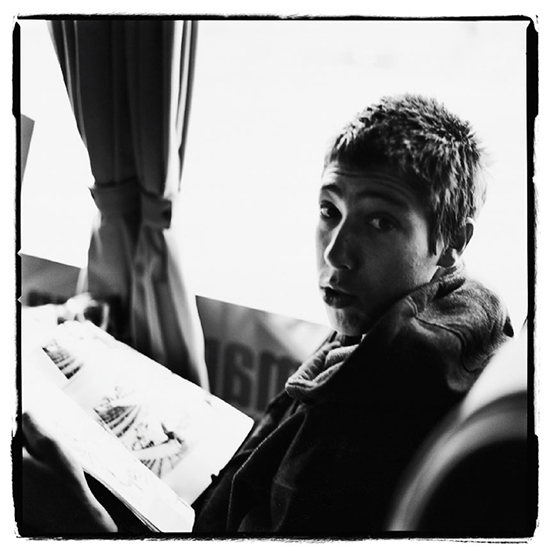 Ryan: What’s always perplexed me is the way people have lumped you in with J.T. Aultz and Spanky. Especially when you were on City Stars, people would group you, Van Wastell and Justin Case together as the crew from the San Fernando Valley. But you’ve basically adopted Newbury Park as your home. And Newbury Park is in Ventura County; it’s not part of the San Fernando Valley. The Agoura crew—who were from the Valley—and the Newbury Park crew never really skated together.
Ryan: What’s always perplexed me is the way people have lumped you in with J.T. Aultz and Spanky. Especially when you were on City Stars, people would group you, Van Wastell and Justin Case together as the crew from the San Fernando Valley. But you’ve basically adopted Newbury Park as your home. And Newbury Park is in Ventura County; it’s not part of the San Fernando Valley. The Agoura crew—who were from the Valley—and the Newbury Park crew never really skated together.
Mike: I know. Even to this day, people think I’m from the Valley. We were definitely two different cliques. When I moved to Newbury Park, both you and I were still learning to skate.
Ryan: Van, Justin, and Stuart Faught were already taking care of business in Newbury Park.
Mike: Yeah, they were. You and I were still learning backside 5-0 grinds.
Ryan: You reminded me recently of how Steve Ireland—who filmed all of us back in the day—would not take you on skate trips. I had to finagle you into the car to go on skate missions with us. In retrospect, that’s incredibly ironic.
Mike: Steve wouldn’t take me unless I was good enough to film. That’s another reason why I practiced so hard: so I could be accepted by Steve. I wanted in on the L.A. skate missions.
Ryan: Think about how humorous that is now. Working to get Steve Ireland’s approval!
Mike: I was the new kid in Newbury Park. You guys had already known each other for so long. I was just trying to fit in.
Ryan: How old were you when you moved from Agoura to Newbury Park?
Mike: I started going to school and hanging out in Newbury Park when I was 15. But I still lived in Agoura. I commuted from Agoura to Newbury Park for about a year, until my family finally moved to Newbury when I was 16. I met you when I was a freshman in high school.
Ryan: Let’s talk about the Girl Skateboards security pass you’d wear to school everyday. (laughs) How did that come about?
Mike: (laughs) Okay. When I lived in Agoura, I was a total dork. Justin Case had a really big influence on me when I met him in Newbury Park. He told me that I couldn’t get away with dumb shit anymore—and that Girl Skateboards pass had to go. I created the pass one day after looking through a skate magazine. There was a photo of Eric Koston at some contest in it. He had an identification card around his neck, just saying that he was a participant; the pass might have even had “Girl Skateboards” written on it. So I thought, “Yeah, I’m going to make one of those passes Eric has!” I immediately went out and bought two large Girl stickers, attached them to a piece of plastic, and wore it on my belt loop. (laughs)
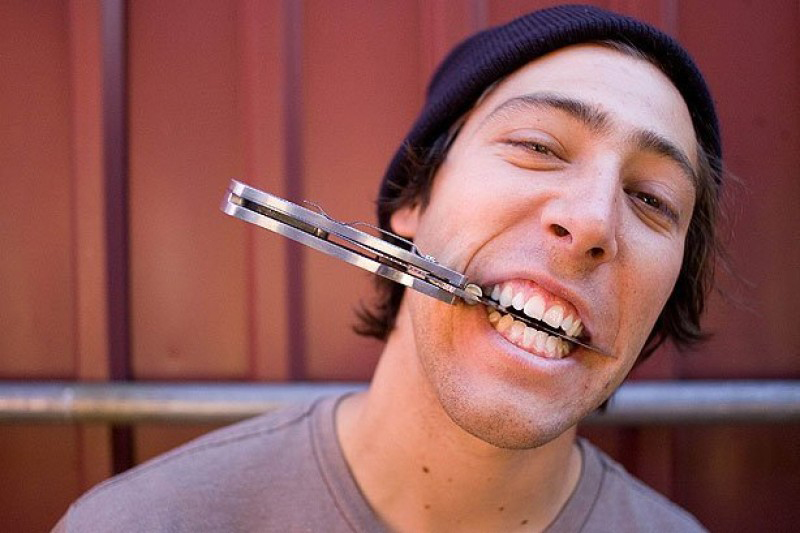
Ryan: You were on the team! (laughs)
Mike: I was! That’s all it took—$1.50 later I was sponsored by Girl. Honestly, had I not moved to Newbury Park, I would have been a totally different person.
Ryan: That’s very true. Looking back on it, there was a single day that had a profound effect on you. It was the day Van Wastell grinded the steep, 12-stair rail at the Thousand Oaks Mall. It really changed the way our crew looked at skateboarding. And there’s a good story behind that trick that’s certainly worth telling.
Mike: Definitely. The day Van grinded the Thousand Oaks Mall rail started out like any other day. Van and I went to a 6-stair rail next to my house called Oak Hills. It was a knee-high square rail, perfect for a beginner. Van rolled up to it for an hour. He couldn’t do it at first, but he really wanted to grind it. Finally, he went for it. Van grinded the rail first try, but kicked out at the end. I think he pulled it on the next try. We were so pumped: “Yeah, you did it! You grinded a handrail!” After Van grinded Oak Hills, we immediately went up the street to this anonymous rail in an apartment building. It was a steep, 9-stair square rail. If we passed by it today, there’s no way we’d skate it because it’s so sketchy. Van rolled up to that rail for about ten minutes and then grinded it. We were tripping so hard. We couldn’t believe he did it. Now I can’t remember the exact details—whether he said “Let’s go to the Thousand Oaks Mall,” or what—but we ended up there. And for those who don’t know, the 12 stair at the Thousand Oaks Mall was our El Toro. Back in the day, it was heavy. If you ollied the stairs there, everyone in town knew about it. Anyway, we arrived there and Van said, “I’m going to grind this rail.” We couldn’t believe it. No one had skated the rail before, just the stairs. The 12-stair rail at the Thousand Oaks Mall is the tallest, steepest rail you could skate.
Ryan: The runway is also curved.
Mike: Yeah. It’s awful. But sure enough, Van 50-50 grinded it. My face probably looked like I had seen a ghost when he pulled it. He went from grinding a beginner’s 6-stair rail in the morning to hitting up the sketchiest 12-stair rail in the afternoon. Van sessioned three rails in a matter of hours. I remember seeing you that day, too. You were with Steve Ireland filming a line at Newbury Park High School. I went up to you and told you that Van had grinded the Thousand Oaks Mall rail. And you didn’t believe me!
Ryan: That was just too heavy. I didn’t think that rail was even possible. It was not something anyone would want to skate. You showed me the footage right then and there and my jaw just dropped.
Mike: That was an incredible day.
Ryan: That’s a day that I will never forget.
Mike: I remember it like it was yesterday, down to the smallest detail. It started out as just another day of skating. And it ended up being something incredible. How long ago was that?
Ryan: I’m pretty sure it went down in early 1999.
Mike: Ten years ago. Amazing.
Ryan: What’s even more amazing is that you and Van went back there like a week later and both grinded it.
Mike: Looking back on it, I should not have been trying that rail. It’s a miracle that I didn’t kill myself. I don’t know what I was thinking. I just wanted to grind it because Van did it. Van was good enough to skate that rail. He even Smith grinded it later.
Ryan: That’s right. It’s in the Consolidated video (Is What it Is).
Mike: Yeah. Consolidated just dubbed his sponsor me tape into their video.
Ryan: It’s pretty incredible the influence Van had on us. The day you grinded the Thousand Oaks Mall rail opened floodgates for you too. You skate handrails really well, but prior to that, you had only messed around on little ones.
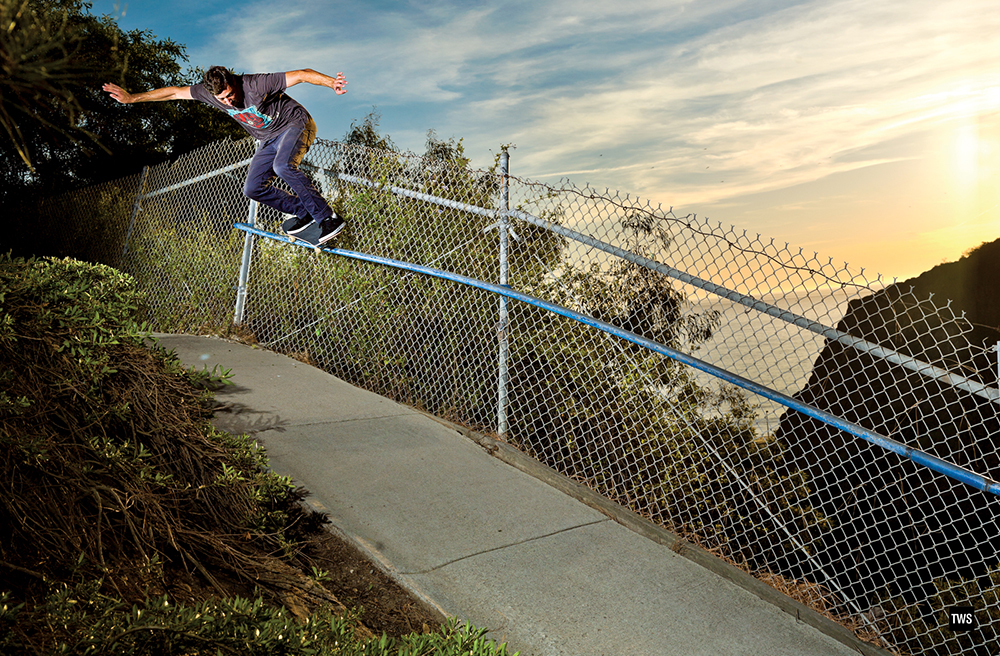
Mike: There was a point where I could finally learn tricks. Van and Justin could already skate. But I remember one day I just felt like I could do tricks—like I had more than 10 down. And I knew then that skating was all I wanted to do. I definitely started skating handrails because of Van. But after a while I found out that it was easier to film a trick on a handrail, because you only have a few tries on them. You have to land a handrail trick fast or you’re in trouble. Tricks on ledges are really difficult. Rails were just easier because I didn’t have to struggle on them. Rails were scary, though. I would roll up to one for an hour before trying it. Steve Ireland would film me, and I’d just keep saying, “Next one, Steve,” over and over again. By the time I did it, my adrenalin would be pumping so hard. I began to like that feeling. Eventually, rails became easier and more fun.
Ryan: Van really propelled you to try bigger and better things.
Mike: He did. And Justin Case influenced me too. Not to say I’m the raddest person around, but I would have been awful had I not met Justin. A mama’s boy. Whack. It would have been totally wrong. I would hangout with Justin and I’d say to him, “Dude, I’ve got to go. It’s 7 PM and my mom wants me home.” And Justin would say, “So? Stop being a pussy. Let’s go skate.” Even though I was older, I looked up to Justin. He’s certainly a big reason I am who I am now. Moving to Newbury was a major event in my life.
Ryan: As whack as Ireland could be, he really got you, Justin, and Van going.
Mike: He really did. And had Stuart Faught kept up with skateboarding near the end of high school, he could have been on Girl or Chocolate. He was so unbelievably good; Steve had a lot to do with that. Without Steve, we wouldn’t have gone to spots or had sponsor me tapes. Ireland helped me out a lot—once he allowed me on trips. He was so into filming Justin. He’d make a new sponsor me tape for Justin every other week. I had to hound him to make just one for me!
Ryan: Your first hookup was Maple Skateboards, correct?
Mike: Yes. Ireland put my video together that I sent out. I remember I mailed all of them out to Justin’s sponsors. He probably had like seven of them back then. Anyway, I didn’t get a call back. (laughs) So I knew I had to send some more out and maybe not shoot so high. Justin was on DC, Alien Workshop…
Ryan: Elwood, Ghetto Child—all of the heavies.
Mike: Exactly. I think I sent out like 25 tapes. I got two call backs: Maple Skateboards and Venture. And even with Venture, it wasn’t a full sponsorship. (Team manager) Justin Williams said, “Hey, man, we liked your tape. The team is full, so we can’t do anything right now. But I can send you a couple of pairs of trucks.” And I was like: “Cool! Hell yeah!” Maple was so great. They sent me like ten boards a month. It was the shit! I think that’s why I’m so spoiled today. I eventually did get some more call backs. My first round of sponsors also included Bones Wheels and Reds Bearings—I couldn’t get Swiss! (laughs)
Ryan: Van and Justin were two early influences. I think Eric Bork was the next guy who really pushed you.
Mike: Bork was a handrail killer. It was when I was skating with him that I would do stuff that hadn’t been done yet. I don’t mean I was inventing new tricks. But there would be a handrail people were skating in videos and I’d do a trick on it that no one had done yet. It was then that I realized I could be on a team. I called either Daxter Lussier or Ed Dominick up at Maple and I said, “Hey, can I get on the team?” And they said, “No.” (laughs) I told Bork that Maple didn’t want me on the team. And Bork said, “Okay. Don’t worry. I’ll get you on Santa Cruz.” And he did. We went on a few trips. I was psyched on that.
Ryan: Switching from Santa Cruz to City Stars was your big break.
Mike: It was. That had a lot to do with meeting Paul Rodriguez, Mike Barker, and the rest of the Valley kids. Paul was already starting to break out. He had that part in the DNA video. It was clear Paul was going to be unbelievable. He was on City Stars already. I didn’t think about riding for City Stars until Justin Case did, though. I remember Justin telling me he quit Alien flow to ride for City Stars; they were going to put him on the team. I thought, “Why would you do that?” Anyway, I went skating with Heath Brinkley—the guy who used to film the Logic videos. He was with Joey Suriel and Ryan Denman. I asked Brinkley if he’d film a trick. Brinkley told me that he would if I turned my Santa Cruz shirt inside out. I asked him why. And he said, “Because you’re going to ride for City Stars.” I just said, “Okay.” I didn’t think anything about it. Then Bork told me he was going on his Mission. By this point, Justin Case was my best friend. So I decided to make the change. I just wanted to skate with my friends. Spanky got on and then Van came aboard a little later.
Ryan: But they missed the Street Cinema (2001) video.
Mike: Yeah. They both did. I really had no idea how big City Stars was going to be. Or how much coverage we would get.
Ryan: What’s amazing about that City Stars team was how all of those AMs came together. I remember in 1999, City Stars was advertising Street Cinema. And with the exception of Danny Garcia—who left the team a short time later—City Stars was a lot of older heads who weren’t actively skating like they were a few years earlier; with a few exceptions like Caine Gayle.
Mike: They were advertising Street Cinema before I started skating!
Ryan: That’s right. The Menace section in Trilogy: “Video Coming Soon.”
Mike: Exactly.
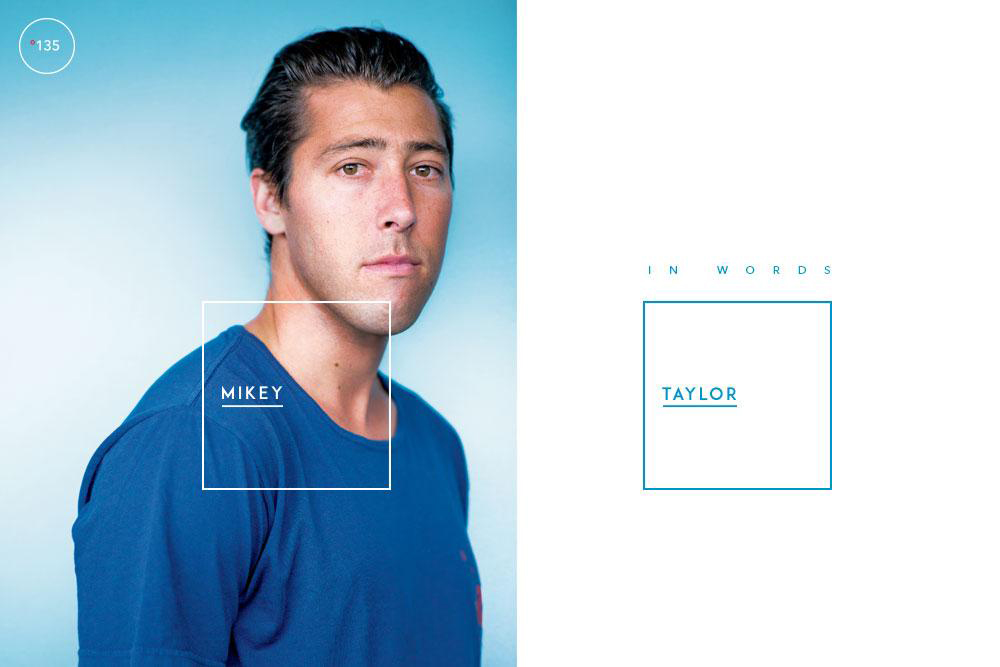
Ryan: It’s weird how a bunch of kids ended up on City Stars. The original Menace team was a group of real street skaters from Los Angeles. Even beyond that, there’s no way a skate team can have an AM roster like City Stars had at that time. Skating is so big right now.
Mike: I know—a bunch of suburban kids on City Stars. I remember when I told Bork that I was going to ride for City Stars. He said, “Wait. Are you kidding me? Do you think that’s a good decision? Do you think you’ll fit on the team?” At that point, City Stars was different.
Ryan: City Stars had hardcore dudes on the roster. The original team ran Lockwood.
Mike: Exactly. And I could barely walk into Thousand Oaks High School! Looking back on it, Paul was the reason everyone was looking at us. He was so good. People wanted to follow him. We received recognition because of him.
Ryan: Sort of road his coattails.
Mike: Yeah.
Ryan: But then you guys picked it up. I was amazed at how much you’d progressed. Your Street Cinema part is incredible.
Mike: That was because of Paul. We had to pick it up. Paul was doing nollieflip noseslides down handrails. We couldn’t just throw down K-grinds anymore. I think in Street Cinema it shows how much fun we were having with skateboarding. We were all such good friends.
Ryan: And you guys were filming each other a lot too.
Mike: Yeah. Paul, Justin and me—we would just skate and film each other. That was probably the easiest part I’ve ever filmed. No one really knew who I was. There wasn’t much pressure. It’s almost like being a musician: Your first album, no one really knows who you are or expects anything. I didn’t even know about criticism! I was just skating to skate. We had a real camaraderie.
Ryan: Let’s talk about the transition from City Stars to Seek.
Mike: Well, Paul left City Stars. When Paul left, I think Kareem looked at me as being the frontman. And I couldn’t be the frontman. I couldn’t keep City Stars afloat. Paul was that team. We were great support. I didn’t have the presence or the hype. I might not have even been good enough.
Ryan: I think that might have been your own insecurities talking. Your skating was really formidable by that point.
Mike: Maybe. But I felt like I couldn’t do it.
Ryan: Justin Case was falling off by that point too.
Mike: Justin was starting to do stupid shit. Spanky called me right after Paul quit. I asked him if he was going to stick around. Spanky said, “I got an offer from Toy Machine”; or some other heavy company like that. In Bloom had just come out which was a big part for me. I was worried about getting stuck. I had an opportunity to go somewhere else with Seek. Anthony Pappalardo really helped me out.
Ryan: In Bloom was major for you. That was released right after Street Cinema and it’s certainly not B-grade material. Two heavy video parts in under a year. You were hitting it hard. Talk about filming for that video.
Mike: I actually didn’t film a lot with the Transworld guys. That one was mainly filmed by Scuba and Dario Rezk. Everything was still pretty much the same as it was with Street Cinema: I was still hanging out with Paul, Scuba was filming; some kids just knew who I was now thanks to the City Stars video. I got hurt a couple of times filming for that video. I crooked grinded that opening rail from my part; immediately afterwards I called Ewan Bowman at Transworld so hyped with the news that filming was underway. The next day I rolled my ankle so bad. I couldn’t go on a Transworld filming trip to Arizona because of my ankle. I was scared that Ewan was getting bummed on me. When my ankle recovered, I filmed some tricks out in Los Angeles, Oxnard, and the Valley. Then I went to Australia with the Transworld guys and cut my shin open so badly. I was with Ewan too. I was stressing. At that point Transworld videos were heavy. And I felt like I was letting them down. So I was really going for it in an effort to impress them. It ended up turning out okay.
Ryan: You had discovered the Moorpark College rails at that point. You and Van were attacking them.
Mike: That was Van. Even if we did the same trick—he’d make it look so smooth. I just wanted that smoothness. Again, I wanted to skate like Van. He pushed me.
Ryan: How long was Seek around before you got on?
Mike: I want to say a year and a half. And then I was on there until it ended—two to three years later. I don’t know what happened to Seek. I think having three board companies going at the same time is a tall order.
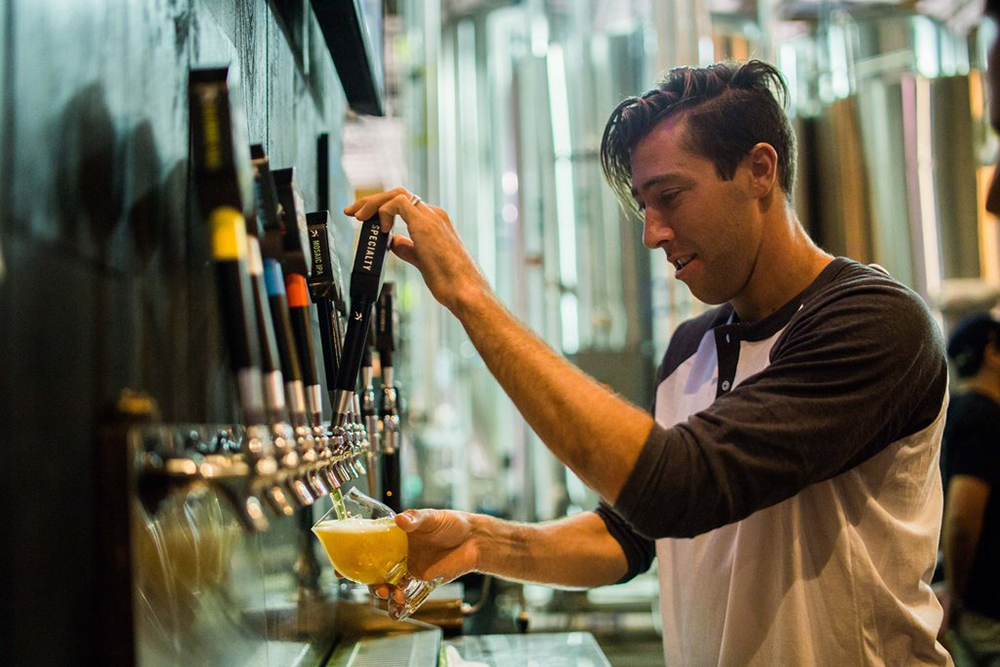
Ryan: Too many cooks in the kitchen.
Mike: Yeah. When they called me after Seek went down and said, “We want you on Alien,” I just thought, “Thank god!” I was so happy.
Ryan: Almost any other step would have been a step down.
Mike: Yeah. It was like a dream come true: “Holy shit. I’m on Alien.”
Ryan: Alien is the total package. Great graphics. Great riders. Great videos. There’s continuity with everything they do. They’re like the Factory Records of skateboarding. Let’s talk about your DVS part. That was different for you. You were skating Europe a lot. And there’s a lot of street transition in your section.
Mike: With Skate More, I started taking into consideration how spots looked. I started realizing that different places were more aesthetically pleasing. I also wanted to skate out of my comfort zone. So I started hitting more transition spots. That first line I do—where I tailslide the top of the bank—I learned how to do that trick that day. I seriously had never skated a ledge on top of a bank! I was still struggling at legitimate transitions at that time. So I had a miniramp built in my backyard, which is probably the best investment I’ve ever made.
Ryan: That transition thing—Van Wastell was the only guy in our age group who could legitimately skate that stuff. And that was because of his older brother Jeff, who grew up in the halcyon days of vert skating. There were no parks in our area with transitions when we were coming up. I remember your dad drove me and you down to Huntington Beach to skate that old skatepark. That was the only one around! And that had banks, a flat bar, and two chewed up ledges!
Mike: Yeah. You and I learned how to skate in the streets: flat ground and ledges. Man, demos would kill me. I’d drop in and just hit the ledges and rails. I had to step it up and learn transition!
Ryan: That’s probably why you just recently cleaned up at Tampa Pro.
Mike: Exactly. I can skate that stuff now thanks to the miniramp I had built. I like transitions now.
Ryan: Let’s talk about Mind Field. Filming for that had to have been stressful, huh?
Mike: Yeah. That’s the most stress I’ve ever felt. The Alien team is gnarly. Everyone on there is so good. I just didn’t want to be the weakest link. I also got hurt a couple of times filming for that video. I broke my hand. I had to have surgery on that. So I was out for two and a half months. I skated for five days after my hand recovered and then completely wrecked my ankle. I rolled the hell out of it at the Los Angeles Community College rails. That put me out for three more months. So that’s five months in a row that I was out. And when I got back, my ankle hurt all day, everyday. It sucked. Looking back at Mind Field, I know what tricks were done when I was in a lot of pain. And it’s almost hard to watch because I know how wrecked I was at that time. It was hard. But I’m stoked how the video came out.
Ryan: Who are you stoked to skate with these days? I know Angel Saucedo has to be one of them.
Mike: Definitely. Angel is from Ventura. Basically, Angel is number one at life. He comes from the sketchiest area. And you’d think that he’d be a scary dude, but he’s the greatest guy ever. He’ll never do you wrong. Angel also rips so hard on a skateboard.
Ryan: He never stresses. He can take a beating hardflipping some huge set, and it’s no big deal. He’s still smiling. He pops out of the car and throws down on whatever is around.
Mike: Yeah. He frontside pop-shuvited a 15 stair. Gnarly.
Ryan: Who is coming up that you’re pumped on?
Mike: Wes Kremer and Tyler Surrey. They’re so good. The whole Skate Mafia team is like the new City Stars to me. They’re all friends. They all rip. They look like they’re having fun. I’m psyched on them. Tyler Bledsoe and Sean Malto are incredible. But they’ve kind of made it. Marquise Henry is mind blowing.
Ryan: So what are you working on right now?
Mike: I think I might film a part for Alien, like how Kalis had that Mono part. I always need something to work on to keep me busy. So we’ll see. Whether it’s just an internet release or if it comes with boards—it’s still up in the air.
